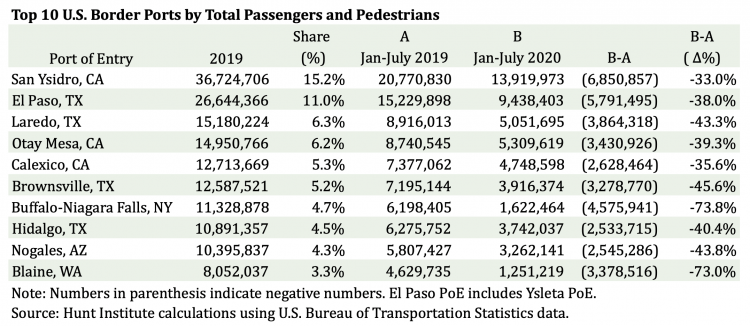 TREND: The onset of the Covid-19 crisis and accompanying restrictions on the U.S.-Mexico border and on the U.S.-Canada border led to noticeable drops in cross-border crossings into the U.S. In coordination with Mexico and Canada, the U.S. limited non-essential travel at the border starting on March 21, 2020. While cross-border trade continued uninterrupted, the slowing down of economic activity due to Covid-19 also had an impact on border crossings. This impact can be seen when analyzing numbers at the top U.S. land ports of entry (PoE).
TREND: The onset of the Covid-19 crisis and accompanying restrictions on the U.S.-Mexico border and on the U.S.-Canada border led to noticeable drops in cross-border crossings into the U.S. In coordination with Mexico and Canada, the U.S. limited non-essential travel at the border starting on March 21, 2020. While cross-border trade continued uninterrupted, the slowing down of economic activity due to Covid-19 also had an impact on border crossings. This impact can be seen when analyzing numbers at the top U.S. land ports of entry (PoE).
•Back in 2019, ten key U.S. land PoE processed 75.5% of all full container truck crossings. Five of the top ten U.S. land PoE for full container truck border crossings in 2019 were located on the U.S.-Mexico border and accounted for 42.1% of full container truck crossings across all U.S. PoE. Among these, the Laredo PoE on the U.S.-Mexico border held the highest rank with 1,711,670 border crossings, an 18.7% share of all full container truck crossings across U.S. PoE. Second from the U.S.-Mexico border was the Otay Mesa PoE ranking 3rd with 759,362 border crossings, an 8.3% share of the total. Third from the U.S.-Mexico border was the El Paso PoE ranking 6th with 610,869 border crossings, a 6.7% share of all full container truck border crossings across U.S. PoE.
•Due to the Covid-19 public health crisis, these top 10 border PoE registered decreases in terms of full container truck border crossings during the January to July 2020 period on a year-over-year basis. Of these, the Laredo PoE and the El Paso PoE witnessed the highest absolute losses, dropping by approximately 135,000 (-13.3%) and 128,000 (-36.1%) full container truck border crossings, respectively.

•In 2019, ten key U.S. land PoE accounted for 65.9% of all passengers and pedestrians crossings. Eight of the top ten U.S. border PoE for total passengers and pedestrians in 2019 were located on the U.S.-Mexico border, while only two were on the U.S.-Canada border. In fact, the top six were on the U.S.-Mexico border and accounted for almost 50% (49.1%) of all of these crossings across U.S. border PoE. The San Ysidro PoE and El Paso PoE were the top two, accounting for more than a quarter (26.2%) of these crossings across U.S. border PoE with approximately 37 million (15.2%) and 27 million (11%) total passengers and pedestrians, respectively. (Note: Total passengers is the total of personal vehicle passengers, train passengers, and bus passengers)
•However, the San Ysidro PoE and the El Paso PoE were the most impacted by the travel restrictions with a decrease in total passengers and pedestrians of approximately 6.9 million (-33%) and 5.8 million (-38%), respectively, during the January to July 2020 period on a year-over-year basis.

TAKEAWAY: The impact of Covid-19 on border traffic has been more extensive than that of the 2018 migration crisis. Efforts to reduce the spread of the virus add to the financial and economic costs of regional border crossings, affecting retail and manufacturing operations, slowing down production, affecting business planning, and employment on both sides of the border. On September 18, the U.S. announced it had agreed with Mexico that temporary restrictions to non-essential travel at the border will continue through 11:59 pm on October 21, 2020.
* Since 2014, the Hunt Institute for Global Competitiveness at The University of Texas at El Paso has provided economic analysis of the Paso del Norte Region that includes the binational communities of El Paso, Texas; Las Cruces, New Mexico; and Ciudad Juárez, Mexico. The mission of the Hunt Institute is to produce high-quality market analysis tools that can strengthen regional and binational cross-border economic and social development. Twitter: @HuntPasoDeNorte


